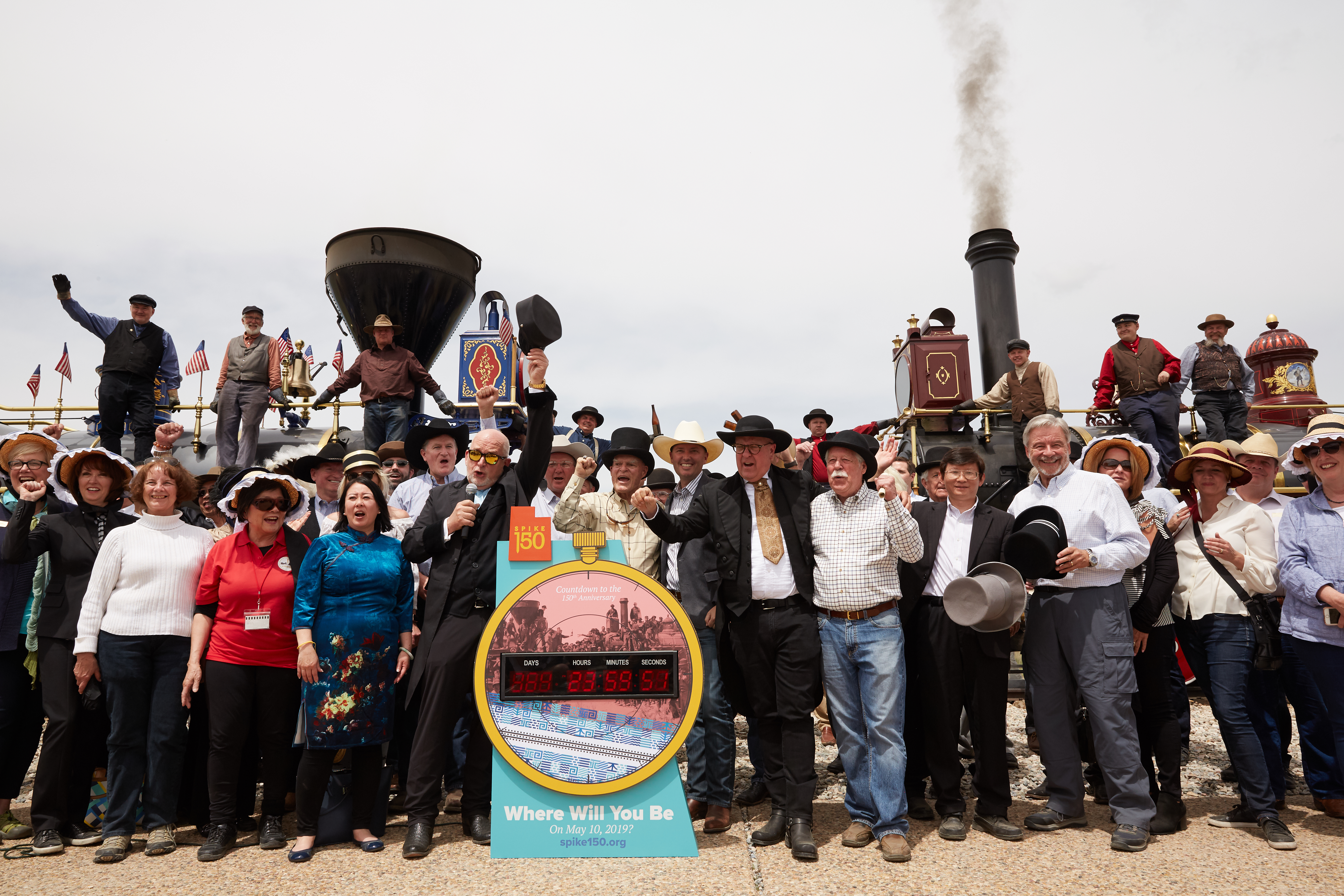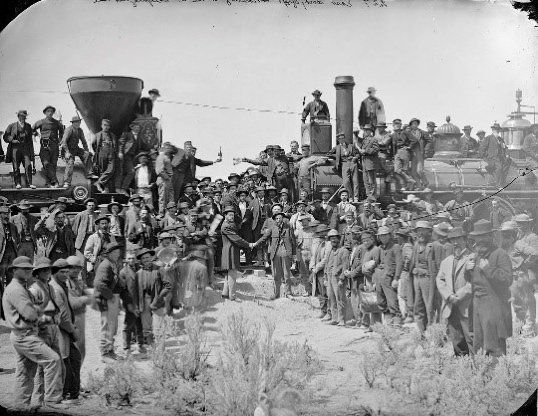
The 150-year Golden Spike anniversary celebrates more than a historic railroad. This year, Utah’s Golden Spike festival focuses on the improvements the railroad made for all Americans, especially minority groups.
“It changed America and the world,” said Ryan Lee, curator of 19th Century Mormon and Western Manuscripts at BYU. “It took transportation from the East Coast to the West Coast from six months to six days, so it revolutionized how people traveled.”
Individuals and organizations across the state spent years uncovering rare artifacts and personal histories for visitors to learn and gain inspiration from. The construction of the Transcontinental Railroad helped unify a disjointed nation after the Civil War, Lee said. Once completed, the railroad enhanced travel, growth and economic success within the United States, according to Lee.
“The economic boom that the railroad helped to create, both here in Utah and across the country, was huge, and then for migration, which I think was a big reason why Brigham Young and others really wanted to help with the project,” Lee said.
On May 9-12, Utah will take center stage in the nation’s 150-year celebration of the completion of the Transcontinental Railroad.
Sarah Singh, head of special collections at Weber State University said, “We’re expecting a quarter of a million people. It’s going to be like the Olympics.”
The peak in interest extends well beyond Utah’s borders. Singh said visitors are coming from across the nation and the world as Utah takes center stage in the nation’s historical anniversary.
“We’ve had contact from groups as far as China and Japan and across the country wanting to have information about what’s happening here,” Sing said. “There are four national railroad associations that will all be having their conventions in northern Utah that weekend.”
As a curator, Singh is extensively involved in bringing together the state’s history and the personal accounts that weave together a rich story of diversity. To bring the railroad to life, Singh’s team researched and interviewed descendants of those who worked on the railroad.

“We reached out to the Chinese, Japanese and African American communities and said all those stories are a part of the railroad story here in Utah and need to be shared and highlighted,” Singh said. “We wanted to make sure all the other groups were involved in not only building the railroad but then also the aftermath and having the growth of the railroad by making sure they’re represented as well.”
While researching ethnic communities, Singh said her team at Weber State University tracked descendants of African Americans who worked on the Transcontinental Railroad. Singh said African Americans began working as porters and waiters on the Transcontinental Railroad when passenger rail picked up momentum.
According to Singh’s research, service jobs on the railroad gave opportunities for comfortable middle-class living that wasn’t available in other career paths for ethnic communities. Singh said that after the Civil War, many African Americans were tenant farmers, so working on the railroad gave them increased pay, the opportunity to travel and family health insurance.
“It really gave them sort of a step-up and created that middle class, and that was the same for the Japanese as well,” Singh said. “There were a lot of Japanese, especially here in Utah, who ended up working for the railroad.”
Lee said the mentality behind building the Transcontinental Railroad and running it was the pursuit of the American dream.
“In many ways, it goes to show that America did work together and support the railroad and each other,” Lee said. “At the time the thinking was, ‘We are still Americans; we support the constitution and want America to prosper, grow and be a wonderful nation.’”
For the past five years, Lee has worked meticulously to bring artifacts from the Transcontinental Railroad to the public. With interactive displays, Lee’s goal is for visitors to get a closer look at The Church of Jesus Christ of Latter-day Saints’ involvement in this part of history.
“The idea of having the railroad here, the migration of members of the Church into the Intermountain West — that was huge,” Lee said.
Lee added that settling the Wild West was another appealing factor for Utah leaders at the time.
Although the Transcontinental Railroad opened an era of growth and innovation, it also closed a chapter in Utah history by bringing an end to the pioneer era.
“The Transcontinental Railroad did technically end the pioneer era on May 10, 1869,” Lee said. “It is definitely good to know there was a drive to bring people together, and the railroad did that. The Church was extending olive branches to people by getting involved in its construction.”
BYU’s Museum of Art is also showcasing the growth of the railroad by displaying rare photographs documenting its construction. The exhibition is a collection displaying a new age of photography and technology during the construction of the railroad.
Curator Ashlee Whitaker brought the exhibition to the BYU Museum of Art to showcase the historical importance of the Transcontinental Railroad’s monumental achievement.
“This exhibition spoke to me because it merges the 150 years of great railroad photography with an interesting and relevant discussion of transformation and change — both locally and nationally — that still impacts us today,” Whitaker said.
The Golden Spike was the last railroad spike, made out of gold, ceremoniously set into place as the final spike in the construction of the Transcontinental Railroad. It celebrated the railroad’s completion, and was “heard” from coast to coast.,
“I call it the first tweet of America,” said Spencer Stokes, Spike 150 event commissioner.
Stokes is working extensively to plan this year’s festivities at the Golden Spike National Historic Site.
To “tweet” the railroad’s completion, Stokes said telegraph wires were attached to the spike. After the spike was set, the telegraph operator sent the message ‘DONE.’ Once the message was sent across the country, Stokes said church bells rang out and cannons were shot off on the east and west coasts to celebrate its completion.
Although the Golden Spike sent the “first tweet across the nation,” Lee said it was purely ceremonial.
“The thing that people always wonder about and question is, ‘Did they actually drive it in with a hammer?’ No, they did not actually hammer it in,” Lee said. “It was very ceremonial at that time. They had them there, even had a specific piece of wood that had four holes driven in it that they were going to drive it in, but it was just symbolic for a ceremony.”
Visitors can view the actual spikes used 150 years ago at the Golden Spike festival and in Salt Lake City.
From the Spike 150 festivities, Stokes said the original spikes will be on display in the Utah State Capitol’s Gold Room. The spikes will be joined with Abraham Lincoln’s signed Pacific Railroad Act and a new copper spike that commemorates the 150 year anniversary of the world’s first transcontinental railroad.
Stokes said visitors will have a short window to see the Continental Railroad Act together with all the spikes. It’s also worth noting that the Pacific Railroad Act of 1862 will be making its first public appearance in 10 years.
After the Transcontinental Railroad was completed, Brigham Young created a spare spike that is on display at The Church of Jesus Christ of Latter-day Saints’ Church History Museum in Salt Lake City.
Located at the newly designated Golden Spike National Historical Park’s Celebration Village, visitors can witness the wedding of the rails and see what life was like 150 years ago.
“There aren’t a lot of areas where you can go to a remote spot that looks like it did 150 years ago,” Stokes said.
Visitors can see how people lived as they worked on the railroad living in the “Hell on Wheels” village May 10-12. On the 10th, the reenactment of the wedding of the rails will be televised to schools across the state.
Visitors will also have the opportunity to celebrate and reflect on the past while looking forward to the future. “The site is located near where the space shuttle boosters were built, and we will have a reenactment of the 119 and Jupiter coming together,” Stokes said.
Throughout a series of events, Utah is set to bring people together from different time periods, backgrounds and cultures — something Singh said the Transcontinental Railroad has successfully done since 1869.
To book tickets to either the Ogden or Golden Spike National Historical Park festivities, visit visitogden.com/goldenspike2019 or spike150.org/events/.




